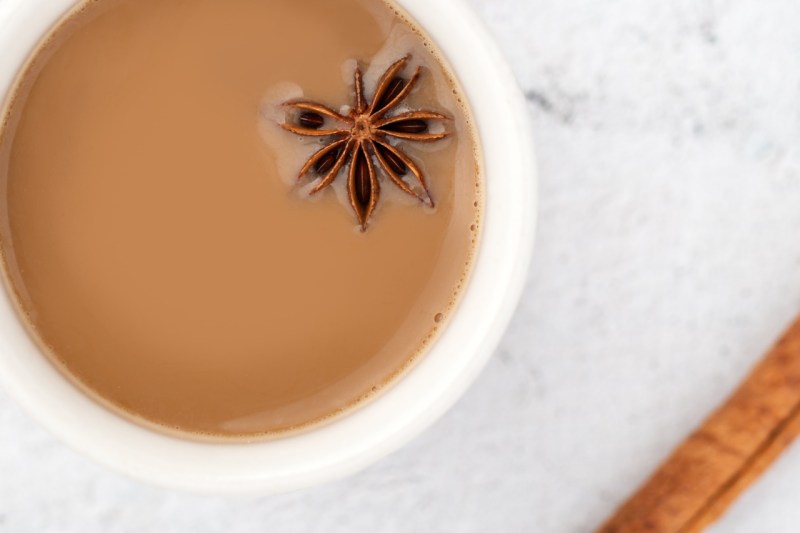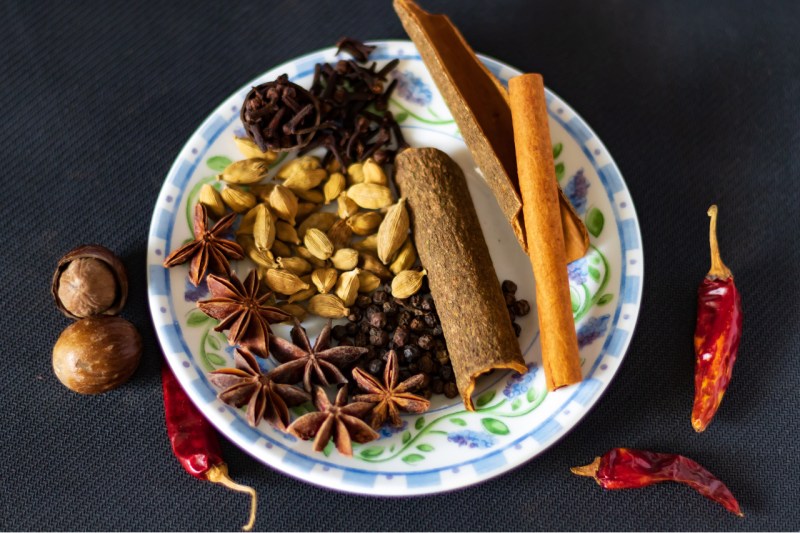
As a beverage, chai has become ubiquitous in America, available everywhere from Starbucks to ice cream. However, most of it is an Americanized version of Indian chai. The traditional Indian chai recipe isn’t just a tea bag in hot water — it’s a brewing process that combines a mixture of spices, sugar, and milk, forming a beverage that’s an integral part of Indian cuisine.
What tea do you use for chai tea?
First, most of the chai consumed in India is known as masala chai (masala means spice blend in Hindi, and chai means tea). A staple in many Indian households and street carts, masala chai can be enjoyed at all hours of the day. Interestingly, while chai is an important part of Indian cuisine, it’s a relatively modern addition. Historically, Indians consumed an herbal beverage called kadha, which is based on a 3,000-year-old Hindu Ayurvedic tradition. Tea, a plant native to China, was introduced to India by the British (a nation famously obsessed with tea) in the 19th century. But for Indians, it wasn’t until the early 20th century that chai was combined with spices, morphing it into today’s popular beverage.
Since Indian masala chai contains an array of spices, strong black tea is the ideal option. For the best teas, choose Assam or Darjeeling, two very popular and common black teas in India. As an option, you can also make the tea stronger or lighter depending on personal tastes. While tea bags will suffice, loose-leaf teas are generally made from higher-quality leaves, producing a better flavor. To save time, you can also make your tea beforehand. Just leave out the milk and place it in the refrigerator when you’re ready to store it. To drink, simply heat some tea with the desired sugar and milk and serve.

What spices are used in chai tea?
Masala chai is traditionally made with an array of spices, including cloves, peppercorns, cinnamon, and others. Generally, whole spices are lightly crushed before being brewed with tea leaves to fuse the flavors properly. Ground spices are another option and can be added and mixed into the finished brewed tea. Although instant masala chai packets are available nowadays at many Indian markets, the flavors of the spices will pale in comparison to the traditional method.
What ingredients are in chai tea?
In India, chai is almost always combined with milk and sugar. Dairy is a large part of the Indian diet, and the addition of fresh milk to masala chai is essential for most drinkers. Unlike European-style black tea, where warm or cold milk is added to brewed tea, milk in Indian chai is boiled together with the brewed tea.
Because the flavors of masala chai can be intense, plenty of sugar is needed to balance the natural bitterness, making this hot beverage quite sweet. Unlike commercialized American chai, Indian chai is served in small cups instead of enormous, fast-food-style Big Gulps. Because of its high sugar content, some modern and more health-conscious recipes will call for alternative sweeteners such as agave or even maple syrup.

Masala chai recipe
This masala chai recipe is courtesy of Sylvia Fountaine, a professional chef, former restaurant owner, and creator of the food blog Feasting at Home. While this recipe calls for whole spices, sugar, and milk, Fountaine has several suggestions for both sweetener and milk. “Instead of the full cup of milk, I typically use a ratio of half water and half milk. Many prefer the richness of a full cup of milk, so feel free to adjust to your taste,” said Fountaine.
Ingredients
- 5-7 green cardamom pods
- 3-4 whole cloves
- 1-2 star anise (optional)
- 5-7 peppercorns (optional)
- 1 cup of water
- 2-3 slices ginger (or more! You can leave the skins on)
- 1/2 cinnamon stick — split lengthwise (use your fingers to separate)
- 1-2 tablespoons loose-leaf black tea, (or 1-2 tea bags) Or substitute decaf black tea
- 1 cup milk of your choice — organic whole milk, almond milk, oat milk, soy milk, cashew milk, hemp milk
- 2-3 teaspoons (or more or less) maple syrup, honey, sugar, or alternative
Method
- Lightly crush cardamom pods, whole cloves, star anise, and peppercorns, and place in a small pot with 1 cup of water. Add ginger, cinnamon, and black tea. I like to muddle the ginger a bit right in the pot.
- Bring to a boil and turn the heat off (don’t continue to boil the tea, it may get bitter), and let it steep for at least 10 minutes or for several hours. The longer it steeps, the more flavor!
- Add your choice of milk. Bring to a simmer once more, and turn off the heat. Stir in your choice of sweetener, taste, adding more sweetener to taste. If it tastes bitter, you need more sweetener. Strain into a chai glass or mug.
- Feel the love. xoxo

Indian chai/adrak (ginger) tea recipe
(By Nikunj Verma)
In India, there are many versions of chai besides masala chai. This adrak (ginger) tea recipe, courtesy of blogger Nikunj Verma, is a great example. “This recipe is from the villages of Western India, where I grew up learning it from my mom, aunts, and grandmother. I make it vegan with almond milk, but sharing with you the original recipe with dairy milk,” said Verma.
Ingredients
- 1/2 inch or 2 teaspoons of fresh ginger, grated
- 1 1/2 cupd water
- 2-3 teaspoons of black tea leaves (If you want to make a strong flavored tea, use 3-4 teaspoons of black tea leaves, it will also give a darker color to the tea. If you want to make a milder version, then 2 teaspoons of black tea leaves is good.)
- 1/2 cup milk
- 1-2 teaspoon sugar (or maple or agave syrup)
Method
- Bring the water to the boiling point and add the grated ginger. Tip: Adding some crushed cardamom will take the flavor of this to another level.
- Boil on a medium flame for 2-3 mins. Add milk and sugar and bring it to boil again.
- Add the tea leaves or tea powder. Simmer until the tea darkens and turns thick for about 5 minutes. You will see the tea reduced to 1 3/4 cup.
- Strain and enjoy the tea.

Chai tea concentrate
If you’re looking to save time, but still want to have chai tea, you can always make a concentrate that you can keep in the refrigerator, so you can make either hot or iced chai whenever you want. The recipe from the Gimme Some Oven blog is pretty versatile, and you can tweak it to your particular chai preferences.
Ingredients
- 12 cardamom pods, crushed
- 8 whole black peppercorns
- 8 whole cloves
- 4-inch piece of sliced fresh ginger
- 4 cups water
- 4 cinnamon sticks
- 3 whole allspice (optional)
- 2 tablespoons brown sugar
- 2 star anise
- 1 vanilla bean, sliced down the middle
- 1/8 teaspoon nutmeg
- 4 black tea bags
Method
- Bring all the ingredients except the tea bags to a boil in a saucepan over medium-high heat.
- Reduce heat to medium-low, cover, and simmer for 15 minutes.
- Add the tea bags and steep for 5 minutes.
- Pour the mixture through a strainer, reserve the liquid for the concentrate, and cool to room temperature.
- To make the chai tea, mix equal parts concentrate with water or milk. You can keep the concentrate in the refrigerator for up to a week.



